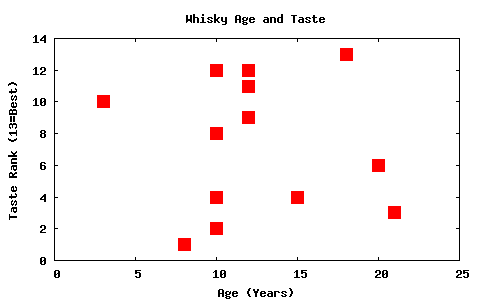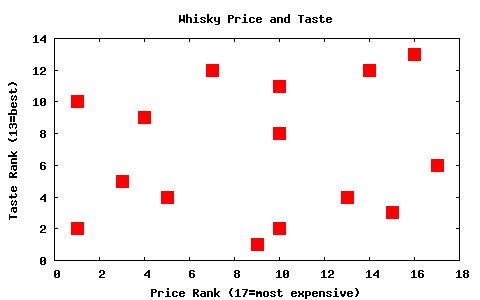When I started reading the intermediate results I was quite impressed. At the top of the list was my "H" whisky, the second most expensive on the panel, and even annotated with the (correct) remark: "Macallan?". If that trend should continue, I thought, I had really underestimated those whisky experts.
The overall result, however, is quite patchy, and here's an attempt at structuring it.
The three Bruichladdich whiskies of various ages - F (10 years), N (15 years), and L (20 years) - have really been judged in that order, i.e. the taster liked the oldest one best. Relatively, the taster is in line with the market here. On the other hand, the oldest of the three whiskies - which was the most expensive on the whole panel - has only reached "upper middle class" ("Glenfiddich?") and thus scored one class under the inexpensive discount whiskies from Aldi and Lidl.
Age preference did not, however, work for the two Glengoyne whiskies - O (10 years) and G (21 years) - both were found to be "lower middle class", with G - the third most expensive whisky on the panel - ranging below O.
Overall, one cannot detect a correlation between whisky age and classification by the taster:

The three blends - and at the same time the three cheapest whiskies - on the panel have brought home varying results. The Famous Grouse ("M") was possibly known to the taster ("Seems familiar. Smells like 'ordinary bar whisky', Johnny Walker or similar") and put in the "upper middle class". Johnnie Walker Red Label ("P") was not identified to be a blended whisky ("Could nevertheless be a higher-class malt, not sure") and also received the "upper middle class" stamp. Old Keeper ("J"), the discount "Aldi" blend, left a funny impression at first ("slightly artificial touch") but at the end of the day was said to be "very good" ("very soft, full-bodied, pleasant"), and the fourth-best whisky on the panel.
The overall rather good results for the blends on this panel seems to support my opinion that they are wrongly regarded as "lesser" whiskies by the market and that more fuss is made over single malts than they, from a purely "tasting" point of view, deserve. A blend is a mixture of different whiskies; this matches the fact that the taster did not notice anything extreme about any of the three. (Four single malts - G, N, F, and A - were unjustly suspected of being a blended whisky.)
The taster does not seem to have noticed that the 12 year old Cardhu ("K") is an important component in Johnnie Walker Red Label. Both were assigned the attributes "malty, smoky", but I cannot really count that since malt and smoke are essential ingredients of all the whiskies tasted here...
In those cases where the taster named a distillery or even age, he was almost always wrong (but anything else would have been superhuman in my eyes). Surprisingly (for me), the 18 year old Macallan ("H") was indeed identified as a (potential) Macallan. The Famous Grouse ("M") was guessed Johnnie Walker (that's the correct direction at least). The Glenfarclas 105 ("A") recevied the - almost derogatory - comment "Johnnie Walker Red Label?". Granted, few people will drink the cask strength stuff undiluted, but the knee-jerk reaction "must be a blend" in such a dire situation seems to confirm that there's a lot of prejudice concerning blends.
The 20 year old Bruichladdich ("L") was assumed to be a Glenfiddich even though both distilleries (and prices as well) are rather far apart.
The 12 year old Glen Ord ("D") with its distillery situated firmly in the Scottish Highlands was spectacularly mistaken for a 16 year old Lagavulin (which is from the Isle of Islay, and in the same price range, but was not on the test panel). But this mistake could have something to do with the fact that the bottle had been open for a while before the test was conducted.
Two whiskies have been named as close companions of the 10 year old Laphroaig (also on Islay, at about 40 €/l, not tested); these were the 7 year old Ledaig ("Q") from the island of Mull and the 8 year old Bowmore Legend ("C") from Islay. At least the classification "island whisky" has worked here. It didn't work for the three Bruichladdichs already mentioned; their distillery is on Islay as well, but the taster didn't notice this with any of the three. This suggests that island whiskies do not necessarily have to carry the marks thought to be "typical" for them (or, as with Glen Ord, occasionally a Highland whisky can have them). I guess it's all a matter of how much peat you throw into the fire...
As stated before: One of the most expensive whiskies was the taster's number one. But, evening the scales, the discount whiskies from "Aldi" and "Lidl" made it to the "very good" category.

The Irish Bushmills ("E"), an inexpensive whiskey commonly found in every Irish Pub in Germany, was given a taste ranking of 2, i.e. second best, together with Glen Ord ("D"). Irish whiskey is distilled three times, Scottish whisky only twice - maybe this makes the Bushmills special on the panel. (Bushmills has one thing in common with the Macallan that was put on #1; they both mature in more than one cask. Unfortunately I do not know whether this is true for others on the panel as well.)
At rank #4 on the taster's hit list we find Old Keeper ("J"), the "Aldi" discount blend and the cheapest product in this test, followed by Ben Bracken ("B"), the cheapest single malt in this test and the trade label of discounter "Lidl".
There is something about this 18 year old Macallan Fine Oak. I had selected it from a private whisky database on the Internet, where it was judged to be a fine whisky by both experts and readers, and lo and behold, my taster rated it at #1 as well. These ratings do not seem to be completely random after all! But as an overall result, I'd like to draw the conclusion: If you use a whisky's price as an indicator for its quality, even partially, you will end up drinking expensive stuff that you don't really like. Apart from the Macallan, my taster depreciated everything the market calls "great and good", and instead rated a blend from the rock-bottom price range as one of the best whiskies. And why not? Even "single malts" are mixed from various casks (and also mixed with water). Why should it be so bad to blend whiskies from different distilleries? Connaisseurs may lament a lack of authenticity - if you can control the taste by blending, what job remains for the distillery? Of course: Extreme touches will be levelled by blending, so if you are looking for a monster peat aroma you'll surely have to grab a single malt. But does that mean that "monster peat" is automatically a sign of superior quality?
I have to admit something myself. My initial mindset on this experiement was that someone who prefers an expensive whisky and cannot reproduce this preference without knowing the price is cheating on himself, and that that's a bad thing. But, coming to think about it: It may be less than optimal because he could have a better taste for less money - but if the nice atmosphere with the happy wee dram at the open fireplace is improved by the elated feeling of drinking a € 5 glass and not a € 0.50 glass - then so be it. The overall experience is not only determined by taste, but by atmosphere as well. In this spirit: Sláinte!
Many thanks to the taster, Andreas Iwanowitsch, for taking part in this experiment. The results are a bit sad for him because he'll have to spend 80 € for a bottle of Macallan now. If he had let the "Old Keeper" win, he'd be saving a full 70 €!
A similar experiment with 56 participants was conducted in late 2006.